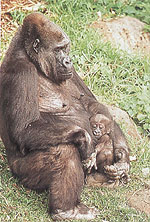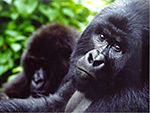MOUNTAIN GORILLA


How to Recognize
Mountain gorillas are the largest of the great apes but very shy. They are completely covered in thick black hair except for their face, chest, soles, and palms. They have short thick trunks and very broad chests and shoulders.
Their eyes and ears are dwarfed by their large heads and hairless, shiny black muzzles. Older males develop a crown of muscle and hair that makes their head look even bigger. Their arms are longer than their stubby legs.
Mature males have a “silver” back and can weigh over 450 pounds. Females are half the size of males. There are only 600 -700 mountain gorillas left in the world and are highly endangered. There is just one mountain gorilla for every 10 million people on earth. (Very sad!)
Habitat
Mountain gorillas are found in the Congo (Zaire) – Rwanda – Uganda border region. They inhabit humid equatorial rainforests up to 13,000 feet. They regenerate secondary forests, valley floors, rainforest clearings and edges, and adjoining cultivation.
Behavior
Mountain gorillas live in non-territorial groups numbering between two and twenty, with the average being ten. The groups consist of one or two older silverback males, younger black-back males, females, and infants. The older offspring are driven out. Mountain gorillas are prone to colds, arthritis, heart disease, and other human ailments.
The silverback makes all the decisions regarding movements, foraging, and where and when to rest. Gorillas aren't big movers, travelling only about half a mile a day. Silverbacks are the chief protector and defender, and they therefore get to eat the best of the food, regardless of who found it. Silverbacks are very patient with their offspring, letting them crawl all over him. They share a special bond and this distinguishes gorillas from other primates as they share child-rearing duties with the females.
The most common sound mountain gorillas make are deep hoots followed by chest beating. They make loud screams and barks but 90% of the time it’s the silverback who is making all the noise.
Conflict between groups is uncommon as gorillas aren't territorial. But if two groups do meet up, it’s at this point that young adult females may choose to switch allegiances. Females also gravitate to solitary silverbacks to form new groups.
At night or for siestas, they build nests on the ground or in trees but they will only use these nests once. Mountain gorillas spend more time on the ground than other apes, moving on all fours but standing to reach for food. They are the only apes that haven't been seen using tools. They spend their time eating and resting, and most often seen lounging in the undergrowth, dozing or basking during sunny spells.
Breeding
A single infant is born after a 8˝-month gestation, and they are nursed until they are 1˝ to 2 years old. Initially, the infant clings to the front of its mother but gradually spends more time on her back. Not all gorillas make it to adulthood with 30% dying before the age of six. Once a female has conceived, she spends most of her life pregnant or nursing every three to four years.
Feeding
Mountain gorillas are vegetarians. They mostly eat wild celery, giant thistles, and gallium vine leaves, shoots, and steams. They also like flowers, fruits, bark, bamboo shoots, and occasionally insects. All of this vegetation contains a lot of water which enables them to survive without drinking for long periods of time. Males develop massive potbellies from the sheer bulk of vegetation they consume.
Enemies
Humans. Poachers have destroyed entire family groups in the attempt to capture infant gorillas for zoos, while others are killed to sell their heads and hands as trophies. When threatened, the mountain gorilla will meet an intruder with roars, chest-beating, thrashing vegetation, and terrifying charges. They rarely attack humans.
TOP OF PAGE
Copyright © 2002, Dawn M. Dalton.
All rights reserved.
**LINKS**
WHERE?
WHY?
ITINERARY
PLAN YOUR TRIP
GETTING THERE
LONDON
KENYA
UGANDA
SAFETY
ITEMS BOUGHT
STAYING HEALTHY
COMMENTS
HOME
BHS HOME
---Animal Facts--
Baboon
Buffalo
Cheetah
Chimpanzee
Crocodile
Eland
Elephant
Gazelle
Giant Forest Hog
Giraffe
Gorilla
Hippopotamus
Hyena
Hyrax
Impala
Jackal
Lion
Mongoose
Monkey
Ostrich
Rhinoceros
Topi
Uganda Kob
Warthog
Waterbuck
Wildebeest
Zebra